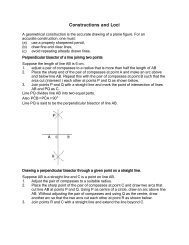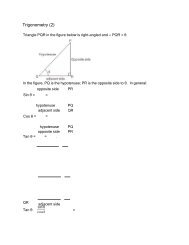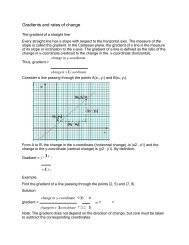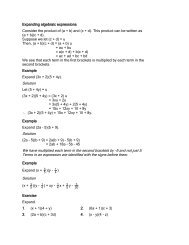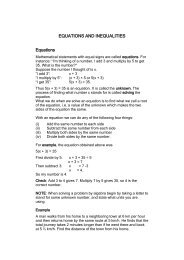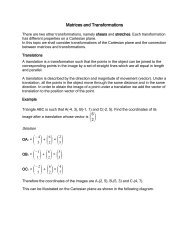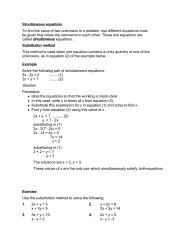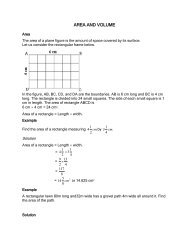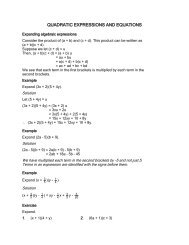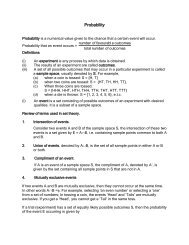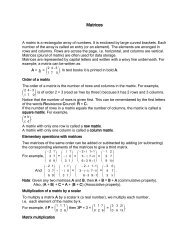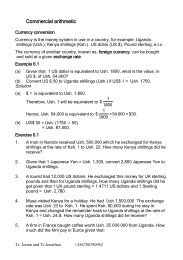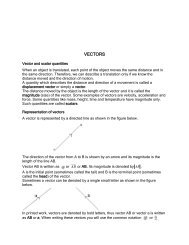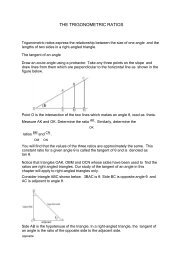J22
You also want an ePaper? Increase the reach of your titles
YUMPU automatically turns print PDFs into web optimized ePapers that Google loves.
Linear programming<br />
Linear programming is a method used to find the best solution to problems that<br />
can be expressed in terms of linear equations or inequalities. Solutions are usually<br />
found by drawing graphs of inequalities and looking for optimum values that satisfy the<br />
required conditions. This method is widely used in business and industrial contexts and<br />
the problems often relate to obtaining maximum profits for given costs and production<br />
levels.<br />
Forming linear inequalities<br />
Some of the terms and symbols that imply inequality include:<br />
less than ().<br />
Less than or equal to (≤)<br />
Greater than or equal to. (≥)<br />
In forming inequalities, we need to define the variables that represent the various<br />
quantities under consideration. For example in a game using a pair of dice, a player<br />
must score a total of more than 9 in order to win. Using y for a number on one dice and x<br />
for a number on the other die, inequalities can be formed<br />
The phrase used to imply inequalities in this case is must score a total of more than 9.<br />
Therefore, the inequality for the winner is x + y > 9 and the statement for the loser is x +<br />
y ≤ 9.<br />
Example<br />
A student went shopping with sh. 15,000 to buy exercise books and pens. An exercise<br />
book costs sh. 500, while a pen costs sh. 200. He had to buy at least 3 exercise books<br />
and not more than 2 pens. Write down inequalities to represent this information.<br />
Solution<br />
We should first define the variables that represent the quantities.<br />
Let x represent the number of exercise books purchased and let y represent the number<br />
of pens purchased.<br />
The inequalities that show the number of exercise books and pens purchased are x ≥ 3<br />
and y ≤ 2.<br />
Each exercise book costs sh. 500 and a pen costs sh. 200. The total amount must not<br />
exceed sh. 15,000. Therefore, 500x + 200y ≤ 15,000. This can be simplified to 5x + 2y ≤<br />
150<br />
The required inequalities are:<br />
x ≥ 3; y ≤ 2; and 5x + 2y ≤ 150.<br />
Exercise<br />
1. Mary went shopping with sh. 8,500 to buy magazines and exercise books. The<br />
cost of a magazine was sh. 1700, while that of an exercise book was sh. 450. She
had to buy at least 2 magazines and 6 exercise books. Write down three<br />
inequalities to represent this information.<br />
2. John has x five thousand shillings notes and y ten-thousand shillings notes. He<br />
has more than sh.30,000 but less than sh. 50,000 in total. The five-thousand<br />
shillings notes are more than the ten-thousand shillings notes. Write down<br />
inequalities relating x and y.<br />
3. On a farm, sh. 750,000 is available for the preparation of planting beans. Two<br />
types of beans, A and B, are to be planted on 4ha. Planting Type A costs sh.<br />
120,000 a hectare, while planting type B costs sh. 150,000 a hectare. Each type is<br />
planted on at least 1 ha. Assuming that labour is available for planting, form<br />
inequalities to represent this information.<br />
4. A wholesaler for animal feeds wishes to transport 240 bags of feed. She has a<br />
lorry that can take 90 bags at a time and a pick-up that can take 20 bags at a time.<br />
The cost of each trip is sh. 50,000 by lorry and sh. 35,000 by pick-up. The pick-up<br />
should make more trips than the lorry. The cost must not be more than sh.<br />
800,000. Write down inequalities to represent this information.<br />
5. A businessperson had 96 m 3 of space available for storage of boxes. There were<br />
two types of boxes, A and B. The volume of type A boxes is 8 m 3 each while the<br />
volume of type B boxes is 8 m 3 each. The businessperson had sh. 720,000 to buy<br />
the boxes. Type A boxes cost<br />
sh. 3,000 each and type B boxes cost sh. 4,200 each. Write down inequalities to<br />
represent this information.<br />
6. A pick-up can carry a mass of 2000 kg. It is supposed to carry type A and type B<br />
bags of animal feed. Type A bags weigh 40 kg each, while type B bags weigh 70<br />
kg each. Type A bags cost sh. 32,000 a bag while type B bags cost sh. 56,000 a<br />
bag. A farmer had sh. 1,600,000 to purchase the feed.<br />
(a) Write down inequalities to represent this information.<br />
(b) Show the inequalities on a graph.<br />
Forming and solving inequalities<br />
Example<br />
A girl went to a book shop with sh. 1200. She bought x exercise books at<br />
sh. 200 each and y exercise books at sh. 250 each.<br />
(a) Form inequalities to represent this information.<br />
(b) Draw graphs to represent this information.<br />
(c) Use the graphs to list all the possible solutions.<br />
Solutions<br />
(a)<br />
The inequalities are:<br />
x ≥ 0 and y ≥ 0, because x and y cannot be negative.<br />
200x + 250y ≤ 1200, because she could not spend more than<br />
sh. 1200. This simplifies to 4x + 5y ≤ 24
(b)<br />
The graphs of the inequalities are shown in the figure below.<br />
The required region is usually determined by substituting selected values of x and y into<br />
the inequalities to check whether they satisfy the inequalities. The coordinates of the<br />
origin are often used. The unwanted region is usually shaded.<br />
(c) From the graphs, the values of x and y must be integers. Therefore, the possible<br />
solutions are the integral coordinates in the wanted region. That is, points such as<br />
(1, 1), (2, 1), (4, 1).<br />
Which other points satisfy the inequalities?<br />
Example<br />
To transport 165 crates of bread, a pick-up and a van are used. The pick-up can carry<br />
15 crates per trip while the van can carry 33 crates per trip. The pick-up makes x trips<br />
and the van makes y trips. The total number of trips must be less than 8.<br />
(a)<br />
(b)<br />
Solution<br />
(a)<br />
(b)<br />
Write the inequalities that represent this information.<br />
Using graphs, determine the possible number of trips each vehicle should make in<br />
order to transport the crates most economically.<br />
The inequalities representing the information are:<br />
x ≥ 0, the number of trips the pick-up makes.<br />
y ≥ 0, the number of trips the van makes.<br />
15x + 33y ≥ 165, the total number of crates to be transported. This simplifies<br />
to 5x + 11y ≥ 55.<br />
x + y < 8, the maximum number of the sum of the trips the pick-up and the van<br />
make.<br />
The graphs in the following figure represent these inequalities.
The solutions are in the unshaded region and on the continuous line. The integral<br />
coordinates in the unshaded region are possible solutions but the most cost<br />
effective ones are close to or on the continuous line. These include (1, 5), (0, 6),<br />
(0, 7), (3, 4), e.t.c.<br />
list other points that give cost effective solutions<br />
Exercise<br />
1. Ali is 3 years older than Moses. Their total age is less than 30 years but more than<br />
26 years.<br />
(a) Form inequalities to represent this information.<br />
(b) Represent this information on graphs.<br />
(c) List all the possible ages of Ali and Moses.<br />
2. A home library should not have more than 140 books. More than 60 of the books<br />
should be fiction and at least 40 non-fictions.<br />
(a) Write inequalities to represent this information.<br />
(b) Use graphs to find the possible number of books of each type in the library<br />
3. Nadia had sh. 2000, enough to buy some mandazi and cakes. She had to buy at<br />
least 3 pieces of each item. Mandazi cost sh. 200 and cakes cost sh. 300 each.<br />
(a) Form inequalities to represent this information.<br />
(b) Represent this information on graphs.<br />
(c) Use the graphs to find all the possible numbers of each item bought.<br />
4. Transport is to be arranged for 420 students. There are two types, A and B, of<br />
passenger vehicles to be used. Type A carries 14 passengers and type B carries<br />
35 passengers. There are to be at least 10 vehicles of type A and not more than 9<br />
vehicles of type B.<br />
(a) Write down inequalities to represent this information.<br />
(b) Draw graphs to represent the information.
(c) List three solutions which satisfy all the inequalities.<br />
5. Some fruit juice is obtained from x oranges and y lemons. For a pleasant taste, 3x<br />
+ 5y must be at least 30. For an attractive colour, 3x must be greater than y.<br />
(a) Write inequalities to represent this information.<br />
(b) Represent the information on graphs.<br />
(c) List three solutions having integral values that satisfy the inequalities.<br />
6. A transport company has buses that carry 70 passengers each, and minibuses<br />
that carry 35 passengers each. There should be at least 10 drivers available and<br />
more than 700 passengers should be transported in a day.<br />
(a) Write down inequalities to represent this information.<br />
(b) Draw graphs to show this information.<br />
(c) List solutions having integral coordinates that satisfy these inequalities.<br />
7. A magazine is to be produced with at least 32 pages but not more than 40<br />
pages. The number of advertisement pages must be at lest half the<br />
number of text pages. There must be at least 27 text pages.<br />
(a) Form inequalities to represent this information.<br />
(b) Draw graphs to represent this information.<br />
(c) List three possible coordinates that satisfy these inequalities.<br />
8. A man had sh. 192,000 to buy trousers and shirts. A pair of trousers costs sh,<br />
24,000 and a shirt costs sh. 16,000. He had to buy at least two shirts.<br />
(a) Write down inequalities representing this information.<br />
(b) Draw graphs to represent the information.<br />
(c) List the possible coordinates that satisfy the inequalities.<br />
9. A vegetable seller bought x tones of cabbages and y tones of carrots. Cabbages<br />
cost sh. 1000 per kg and carrots cost sh. 2000 per kg. He had sh. 96,000 to spend.<br />
(a) Write down inequalities to represent this information.<br />
(b) Show the inequalities on graphs.<br />
(c) Use your graphs to list the possible solutions that would satisfy the<br />
inequalities.<br />
Optimization<br />
Optimization is the process of finding the ordered pairs of variables that give the<br />
maximum or the minimum values of given expressions. These ordered pairs of variables<br />
are found in the region that satisfies all the inequalities. The process of finding the<br />
maximum and minimum values of linear functions under limiting conditions is called<br />
linear programming.<br />
Example<br />
(a) Draw the graphs of x ≥ 0, y ≥ 0, 3x + 2y ≥ 12 and y + 2x ≤ 10.<br />
(b) Find the maximum and the minimum values of 3x + y.<br />
Solutions
(a)<br />
(b)<br />
The graphs of the inequalities and the required region are shown in the following<br />
figure.<br />
To find the maximum and minimum values of 3x + y, we consider the values of the<br />
integral coordinates at the vertices of the required region. These are P(0, 10), Q(0,<br />
6), R(4, 0) and S(5, 0).<br />
At P(0, 10); 3x + y = 10.<br />
At Q(0, 6); 3x + y = 6.<br />
At R(4, 0); 3x + y = 12.<br />
At S(5, 0); 3x + y = 15.<br />
The maximum value of 3x + y in the given situation is 15 and the minimum value is<br />
6. All the other coordinates give values between these two.<br />
Example<br />
A shopkeeper bought two types of animal feed. Type A costs sh. 750 per kilogram and<br />
type B costs sh. 600 per kilogram. She had sh. 15,000 available and decided to buy at<br />
least 18 kilograms altogether. She also decided to buy at least 6 kg of type A feed. She<br />
made a profit of sh.200 per kg of type A and<br />
sh. 250 per kg of type B.<br />
(a) Write down inequalities to represent this information.<br />
(b)<br />
(c)<br />
Solution<br />
(a)<br />
Show these inequalities on graphs.<br />
Assuming that she can sell all the feed, find how many kilograms of each type of<br />
feed she should buy to maximize her profits and find how much the profit is.<br />
Let x represent the number of kilograms of type A and y represent the number of<br />
kilograms of type B. The inequalities are:<br />
x ≥ 6, the number of kg of type A.<br />
y ≥ 0, the number of kg of type B.
x + y ≥ 18, the total number of kg.<br />
750x + 600y ≤ 15000, the amount of money available. This simplifies to 5x<br />
+ 4y ≤ 100.<br />
(b)<br />
The graphs in the following figure represent the above information.<br />
(c)<br />
From the information, the profit made is 200x + 250y. To find the maximum profit,<br />
we substitute the integral values of x and y at points S, T, U and V in the<br />
expression 200x + 250y.<br />
At S(6, 17); (200 × 6) + (250 × 17) = 5,450<br />
At T(8, 14); (200 × 8) + (250 × 14) = 5,100<br />
At U(10, 12); (200 × 10) + (250 × 12) = 5,000<br />
At V(18, 2); (200 × 18) + (250 × 2) = 4,100<br />
She should buy 6 kg of type A and 17 kg of type B to make maximum profit.<br />
The maximum profit is sh. 5,450.<br />
When looking for the maximum value, we use the integral values near or on the<br />
upper boundary of the region.<br />
The objective function<br />
In the above examples, we used trial and error method in order to determine<br />
the maximum or the minimum values of a situation. An alternative method is to<br />
use the objective function or a search line. The line is of the form ax + by = k,<br />
where a, b, and k are constants.<br />
Example<br />
(a) Draw the graphs of the following inequalities: x ≥ 0, y ≥ 0, x + y ≤ 6 and<br />
9x +4y ≤ 36.<br />
(b) From the graphs, find the maximum value of 2x + y.
Solutions<br />
(a)<br />
The graphs of the inequalities are shown in the following figure.<br />
(b)<br />
To find the maximum value of 2x + y, the objective function would be<br />
2x + y = k. The constant k can take any value, but it is appropriate to take a value<br />
of k that is a common multiple of the coefficients of x and y. The multiples of 1 and<br />
2 are 2, 4, 6, … In this case, we can take k = 4. The equation becomes 2x + y = 4.<br />
When y = 0, x = 2. when x = 0, y = 4. We can draw the graph of this line using the<br />
points (0, 4) and (2, 0). The graph drawn is called a search line.<br />
With a ruler and a set square, draw a parallel line to the search line as follows:<br />
<br />
<br />
<br />
Place the longest side of the set square on the search line.<br />
With the ruler firmly held onto one of the shorter sides of the set square, slide<br />
the set square along the ruler until the last point in the required region nearest<br />
to the upper boundary is reached.<br />
If the last point does not have integral values, take the nearest point within the<br />
neighborhood that has integral values. This is the required point.<br />
In this case, the line passes through (2, 4), (4, 0) and (3, 2) all of which give 2x + y<br />
= 8. Thus the maximum value of 2x + y is 8.<br />
To find the minimum value of a function you follow the same steps, but this time<br />
you look for integral values on the lower boundary of the region.<br />
Exercise<br />
1. Draw graphs t represent the following inequalities by shading the unwanted<br />
regions: x + y ≤ 10, y ≥ 2, and y ≤ 2x.<br />
Use the graphs to find the maximum value of:<br />
(a) 2x + 3y. (b) 3y – x.<br />
2. Show the region represented by the following inequalities: 5x + 4y ≤ 40,<br />
9x + 12y ≥ 36, y > x, and x ≥ 1.
(a)<br />
(b)<br />
List all the solutions having integral coordinates.<br />
From the graphs, find the minimum and maximum values of<br />
3x + 5y.<br />
3. Show the region represented by the inequalities: x + y > 10, x < 3,<br />
2x + y 0.<br />
Find the points with integral coordinates which satisfy all the inequalities<br />
simultaneously. For these points find:<br />
(a) the maximum value of 2x + y.<br />
(b) the minimum value of 2x + y.<br />
(c) the maximum value of x – y.<br />
4. Graphically show the region represented by the inequalities: y ≥ 0<br />
x + y ≥ 6 and x + 3y ≤ 12.<br />
(a) Find the values of 3x + 2y at each point with integral coordinates in the<br />
region.<br />
(b) Which is the greatest value?<br />
(c) Find the maximum and minimum value of 4x + 5y.<br />
5. Caroline had sh. 1,500 to buy oranges and mangoes. Oranges cost<br />
sh. 150 each, while mangoes cost sh. 100 each. She bought at least 11<br />
fruits altogether.<br />
Let x be the number of oranges and let y be the number of mangoes she<br />
bought.<br />
(a) Write down the inequalities representing this information.<br />
(b) Represent the information in a graph.<br />
(c) Find the possible combinations of the number of fruits she could buy.<br />
6. Jackline was to buy pens and pencils. She had sh. 9,000 to spend. Each pencil<br />
cost sh. 100, while a pen cost sh. 150. She had to buy at most 30 pencils and<br />
more than 20 pens. She was supposed to buy not more than 70 pens and pencils<br />
altogether.<br />
(a) Write down inequalities to represent this information.<br />
(b)<br />
(c)<br />
Draw graphs to represent the information.<br />
Use your graphs to find the maximum number of pens and pencils<br />
she could buy.<br />
7. A chef makes cakes of type A and type B. He has 2 kg of flour and 1.2 kg<br />
of sugar. Type A cakes use 500g of flour and 100g of sugar. Type B<br />
cakes use 300g of flour and 200 g of sugar. He wishes to make more<br />
than 4 cakes altogether.<br />
(a) Write down inequalities to represent this information.<br />
(b) Represent this information on graphs.<br />
(c) Find the number of type A and type B cakes that he can make.<br />
8. A painter can spray a van in 3 hours and a car in 2 hours. He sprays for at least 15<br />
hours a week. He must spray at least three times as many cars as vans and not<br />
more than 8 cars in a week.<br />
Let x be the number of vans and y be the number of cars he sprays each week.<br />
(a) Write down inequalities representing this information.<br />
(b) Draw graphs to represent the information.
(c)<br />
(d)<br />
Use the graphs to list the combination of the vehicles he could spray in a<br />
week.<br />
Find the maximum number of vehicles he could spray in a week.<br />
9. The manager of a badminton team has sh. 180,000 to buy new uniforms for the<br />
players. She can buy type A uniform for sh. 36,000 each and type B uniform for sh.<br />
27,000 each. She must buy at least two uniforms of type A. The total number of<br />
uniforms must be at least 5.<br />
(a) Write down inequalities to represent this information.<br />
(b)<br />
(c)<br />
Draw graphs to represent the information.<br />
Use your graphs to list down the combinations of the uniforms she could<br />
possibly buy.<br />
10. An electronic dealer wishes to stock 20 television sets. She can buy<br />
Coloured ones for sh. 150,000 each, and black and white at sh. 90,000<br />
each. She has a total of sh. 2,700,000 to spend and must have at least 6<br />
sets of each type.<br />
(a)<br />
(b)<br />
If she buys x sets of black and white and y sets of coloured TVs, write<br />
down the inequalities representing this information.<br />
If she makes a profit of sh. 60,000 on each of the black and white TV set<br />
and sh. 80,000 on each colour TV set:<br />
(i) Write down the equation for the profit.<br />
(ii) Use a search line to find the maximum profit.<br />
11. Mubarak has 36 acres of land. He declares to prepare the land for<br />
planting wheat and maize. The cost of planting maize is sh. 30,000 per acre, while<br />
it cost sh. 90,000 to plant an acre of wheat. Maize takes 3 labourers per acre,<br />
while wheat takes 6 labourers per acre. He hired 72 labourers and spent sh.<br />
1,500,000 for labour costs. He hopes to make a profit of sh. 200,000 per acre of<br />
maize and sh. 450,000 per acre of wheat.<br />
(a) Write down inequalities representing this information.<br />
(b) Show the inequalities on graphs.<br />
(c) Find the maximum profit Mubarak should make.<br />
(d) What would be the most profitable arrangement?<br />
12. Ten students went to buy snacks from a restaurant. They each bought either a<br />
scone or a cake. A scone cost sh. 50, while a cake cost sh. 200. The students had<br />
sh. 10,000 altogether. They bought more scones than cakes.<br />
(a) Form inequalities to represent this information.<br />
(b) Graph these inequalities, showing the wanted region.<br />
(c) List the possible solutions.<br />
13. A transportation firm has 6 lorries which can carry 8 tonnes each The firm also has<br />
4 lorries which can carry 12 tonnes each. The cost of running an 8-tonne lorry is<br />
sh. 80,000 per trip, while that of a 12-tonne lorry is sh. 100,000. There are 600<br />
tonnes of rice to be transported and sh. 1,200,000 available to run the lorries.<br />
(a) Write inequalities to represent the information.<br />
(b)<br />
(c)<br />
Draw the inequalities on graphs.<br />
How should the firm use the lorries in order to incur the lowest costs<br />
possible?
14. Some fruit juice is made from x oranges and y lemons. For a strong taste,<br />
3x + y should be at least 24. For an attractive colour, 2x must be greater<br />
than y. An orange costs sh. 200, while a lemon costs sh. 150<br />
(a) Form inequalities to represent to represent this information.<br />
(b) Show the inequalities on graphs.<br />
(c) Find the cheapest way of making the fruit juice.<br />
15. Ali has sh. 240,000 to buy shirts and trousers. The cost of a shirt is<br />
sh. 32,000, while the cost of a pair of trousers is sh. 50,000. He has to buy at least<br />
two shirts and one pair of trousers.<br />
(a) Write down inequalities representing this information.<br />
(b) Draw graphs to represent the information.<br />
(c) List the possible number of shirts and pairs of trousers Ali can buy.<br />
(d) What is the maximum number of shirts and pairs of trousers he can buy?<br />
16. A factory makes two types of items, A and B. To produce item A costs<br />
sh. 800 plus a labour cost of sh.1,200. To produce item B costs sh.700 plus a<br />
labour cost of sh. 1,600. The cost of producing the items should not exceed<br />
sh.140,000 and labour costs should not exceed sh. 25,000.<br />
(a) Write down the inequalities representing this information.<br />
(b)<br />
(c)<br />
Draw graphs of the inequalities in (a).<br />
Find the maximum number of items A and B that can be produced when<br />
the production cost is maximum.<br />
17. A cultural theatre has a capacity of 240 seats. The seats are sold at<br />
sh. 8000 or sh. 12000. To cover the costs, the management has to collect at least<br />
sh. 144,000.<br />
(a)<br />
(b)<br />
(c)<br />
(d)<br />
Write down linear inequalities to represent this information.<br />
Graph the inequalities, showing the wanted region.<br />
List down the possible solutions.<br />
Determine the solution that gives the maximum profit.<br />
18. A firm is planning to build a factory which will occupy a space of 720 m 2 . Two types<br />
of machines, X and Y, are to be installed. Machine X occupies a space of 60 m 2 ,<br />
requires 3 labourers and produces 8 units. Machine Y requires a space of 80 m 2 , 5<br />
labourers and produces 12 units. There are 75 workers available.<br />
Determine the number of machines of each type that should be installed in order<br />
to maximize production and profits.<br />
19. A hotel is to buy at most 5 bags of cabbages and at most 7 bags of potatoes. A<br />
bag of cabbages costs sh. 45,000, while a bag of potatoes costs sh. 80,000. The<br />
total cost must not exceed sh. 600,000.<br />
(a) Form inequalities to represent this information.<br />
(b)<br />
(c)<br />
Draw graphs of the inequalities, showing the wanted region.<br />
Determine the maximum number of bags of cabbages and potatoes that<br />
can be purchased.<br />
20. A depot for famine relief should have at most 20 bags of rice and 35 bags<br />
of maize. The mass, volume and number of meal ratios per bag are as<br />
shown in the table below.
Bag of Mass (kg) Volume (m3) No. of meals<br />
Rice 25 0.05 800<br />
Maize 10 0.05 160<br />
A delivery van is to carry the largest possible number of bags. It can carry<br />
a mass of up to 600 kg occupying 2 m 3 .<br />
(a) If a load is made up of x bags of rice and y bags of maize, write down four<br />
inequalities (other than x ≥ 0 and y ≥ 0) which govern the relationship<br />
between x and y.<br />
(b)<br />
(c)<br />
Draw a graph to show the inequalities in (a) above.<br />
Determine the number of bags of rice and maize that should be delivered<br />
to make the total number of meal ratios the largest.<br />
21. Give the inequalities that define the unshaded region R in each of the following.<br />
(a)<br />
(b)<br />
(c)
22. Give the points whose coordinates are integers and lie in the unshaded region.<br />
23. Draw a graph and give the integral coordinates of the points that lie in the region<br />
defined by the inequalities:<br />
y > x – 2, 2y < 3x + 6, x + y > -2 and x + y 3<br />
24. The graph below shows regions A to F enclosed by lines x + y = 4,<br />
1 5<br />
y = x and y = x 4 .<br />
3 3
Use inequalities to describe region:<br />
(a) A (b) B (c) C (d) D (e) E (f) F



